Overview
This article delves into the key differences between Kanban and Agile methodologies, particularly in the context of startups. It emphasizes how each framework distinctly influences project management and team dynamics.
- Kanban is identified as the superior choice for continuous workflow and task management,
- Agile stands out for its flexibility and iterative development.
These insights are crucial for startups as they navigate the decision-making process to select the most appropriate approach tailored to their specific needs.
Are you considering which methodology will best support your team’s objectives? Understanding these differences can provide essential guidance.
Introduction
Understanding the distinct methodologies of Kanban and Agile is crucial for startups striving to enhance their project management strategies. Each framework offers unique advantages:
- Kanban provides visual workflow management.
- Agile emphasizes flexibility and continuous improvement.
As startups navigate the complexities of modern business, the challenge lies in determining which approach aligns best with their operational needs and team dynamics.
What are the key differences between these methodologies? How can startups leverage them to maximize productivity and responsiveness? These questions are essential for fostering a strategic approach to project management.
Casy: Automate Task Management for Agile and Kanban Workflows
Casy functions as an unseen manager, effortlessly automating task management for both kanban vs agile workflows. By integrating with popular platforms like Slack and Telegram, Casy captures essential information from conversations, converting discussions into actionable tasks. This automation significantly reduces the time spent on manual updates and minimizes the risk of miscommunication. As a result, teams can concentrate on their core activities.
In 2025, startups can utilize Casy's capabilities to boost productivity and simplify their management processes, ultimately leading to better outcomes. Consider this: task overruns decrease by 35% when AI is utilized in management, underscoring the effectiveness of Casy's automation features. With 84% of users indicating enhanced efficiency after integrating AI into their management practices and 61% of companies utilizing AI in their processes, Casy emerges as an essential tool for startups looking to optimize their workflows and attain greater success.
To get started, startups should consider integrating Casy into their existing communication platforms. Why not experience these benefits firsthand? This strategic move could transform your management processes and drive your startup toward greater achievements.
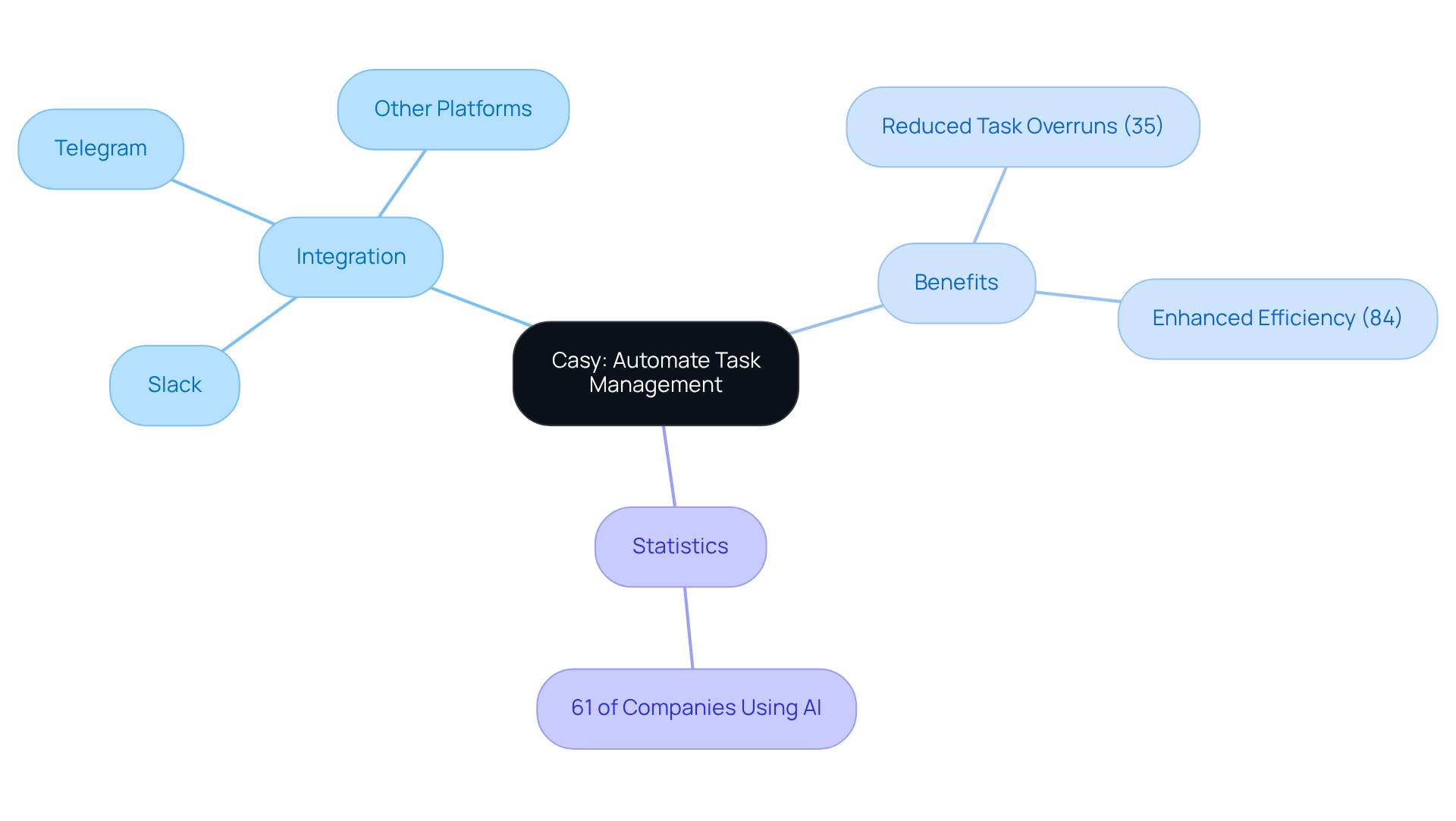
Kanban: Visualize Workflows and Enhance Team Collaboration
This visual management framework empowers teams to effectively illustrate their workflows through boards and cards. Such a method significantly enhances collaboration by providing a transparent overview of tasks in progress, completed tasks, and upcoming work. By imposing limits on work in progress (WIP), this approach enables teams to focus on completing tasks efficiently, thereby reducing the risk of overload.
Have you considered how this could transform your team's productivity?
Startups stand to benefit immensely from the simplicity and effectiveness of kanban vs agile in managing ongoing tasks while adeptly adjusting to shifting priorities.

Agile: Embrace Flexibility and Continuous Improvement
This project management approach represents a methodology that prioritizes flexibility and ongoing enhancement, making it particularly well-suited for startups navigating dynamic environments. By empowering teams to adjust their strategies based on real-time feedback and evolving needs, this methodology fosters a cyclical development process. This process involves completing tasks in smaller increments, enabling teams to regularly assess their progress and implement necessary adjustments. Such a framework not only boosts responsiveness but also nurtures a culture of continuous improvement—an essential element for startups aiming to innovate and achieve sustainable growth.
Consider the impact: organizations that embrace this flexible approach report an impressive 93% improvement in customer satisfaction and a 76% increase in employee engagement. These statistics underscore the methodology's effectiveness in driving innovation and operational excellence. Furthermore, flexible methodologies empower marketing teams to prioritize tasks more efficiently, with 76% of marketers utilizing these practices noting enhanced productivity.
As startups increasingly adopt adaptive methodologies, they position themselves to excel in competitive markets, leveraging flexibility as a fundamental driver of success. However, it's crucial to acknowledge the challenges that may arise. Inadequate leadership involvement, cited by 41% of respondents, highlights the need for strong support in the adoption of flexible methodologies. Are you ready to embrace this approach and elevate your startup's potential?
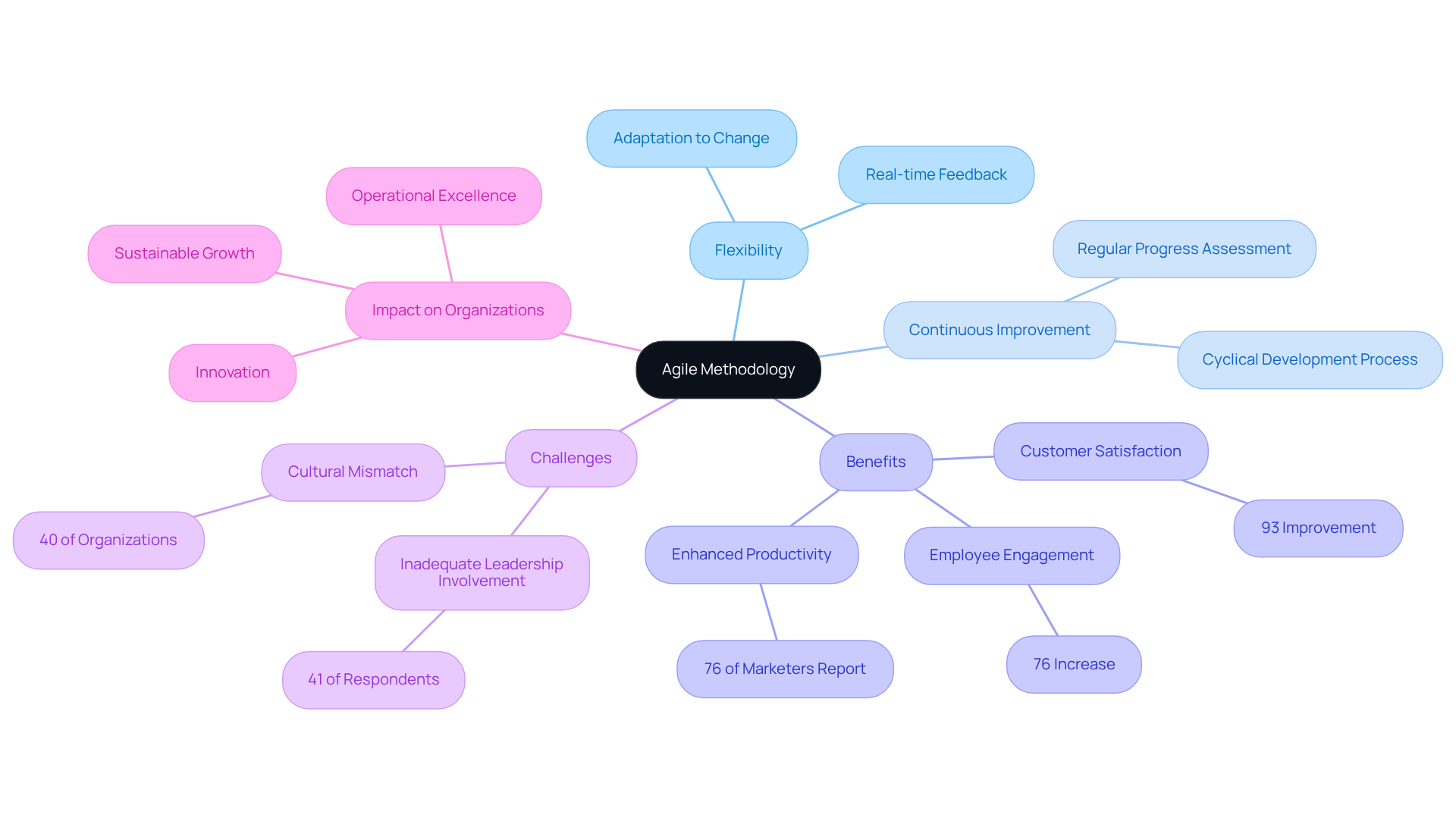
Key Focus: Kanban's Flow vs. Agile's Iteration
Kanban primarily emphasizes sustaining a continuous workflow, allowing teams to pull tasks as capacity allows. In contrast, Agile operates through iterative cycles—known as sprints—where teams plan, execute, and review their work within defined timeframes. Understanding the distinction of Kanban vs Agile is crucial for startups, as it significantly influences how they manage their initiatives and respond to changes.
The comparison of Kanban vs Agile indicates that:
- Kanban is ideal for projects requiring ongoing adjustments.
- Agile is better suited for those with clearly defined phases and deliverables.
How does your team approach project management? Recognizing these methodologies can empower you to choose the right framework that aligns with your project needs.
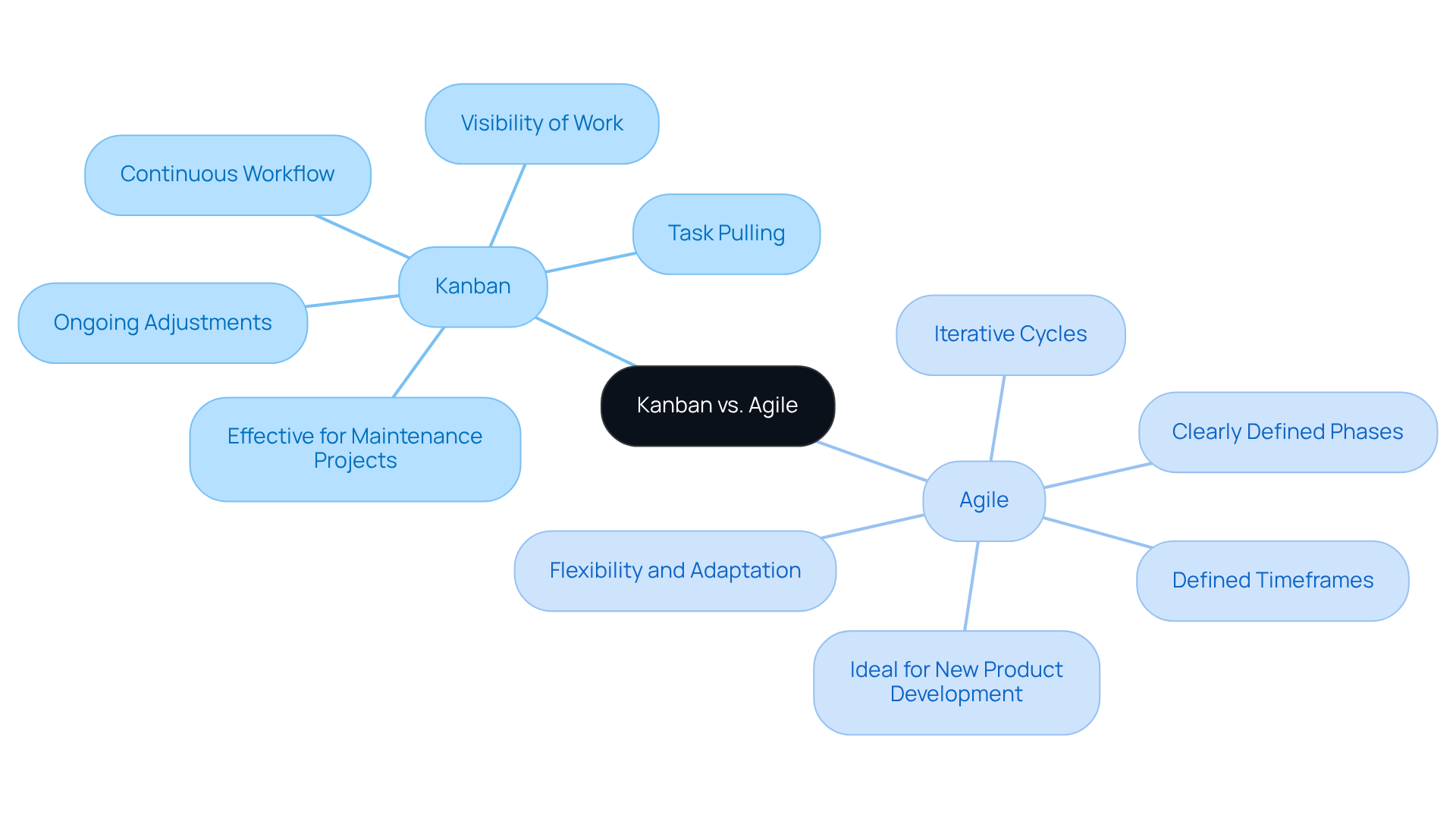
Team Roles: Kanban's Collaboration vs. Agile's Cross-Functionality
In Kanban, group roles are notably fluid, emphasizing collaboration among members without predefined titles. This flexibility empowers teams to adapt swiftly to evolving tasks and priorities. Conversely, flexible methodologies typically engage cross-disciplinary groups with clearly defined responsibilities, such as Scrum Master and Product Owner, facilitating organized procedures.
Startups must carefully consider their project needs when defining group roles, as both approaches present unique advantages in fostering collaboration and efficiency. How can your team leverage these methodologies to enhance productivity?
The choice in the comparison of Kanban vs Agile, particularly between Kanban's fluidity and the structured approach of flexible methodologies, can significantly impact your team's effectiveness.
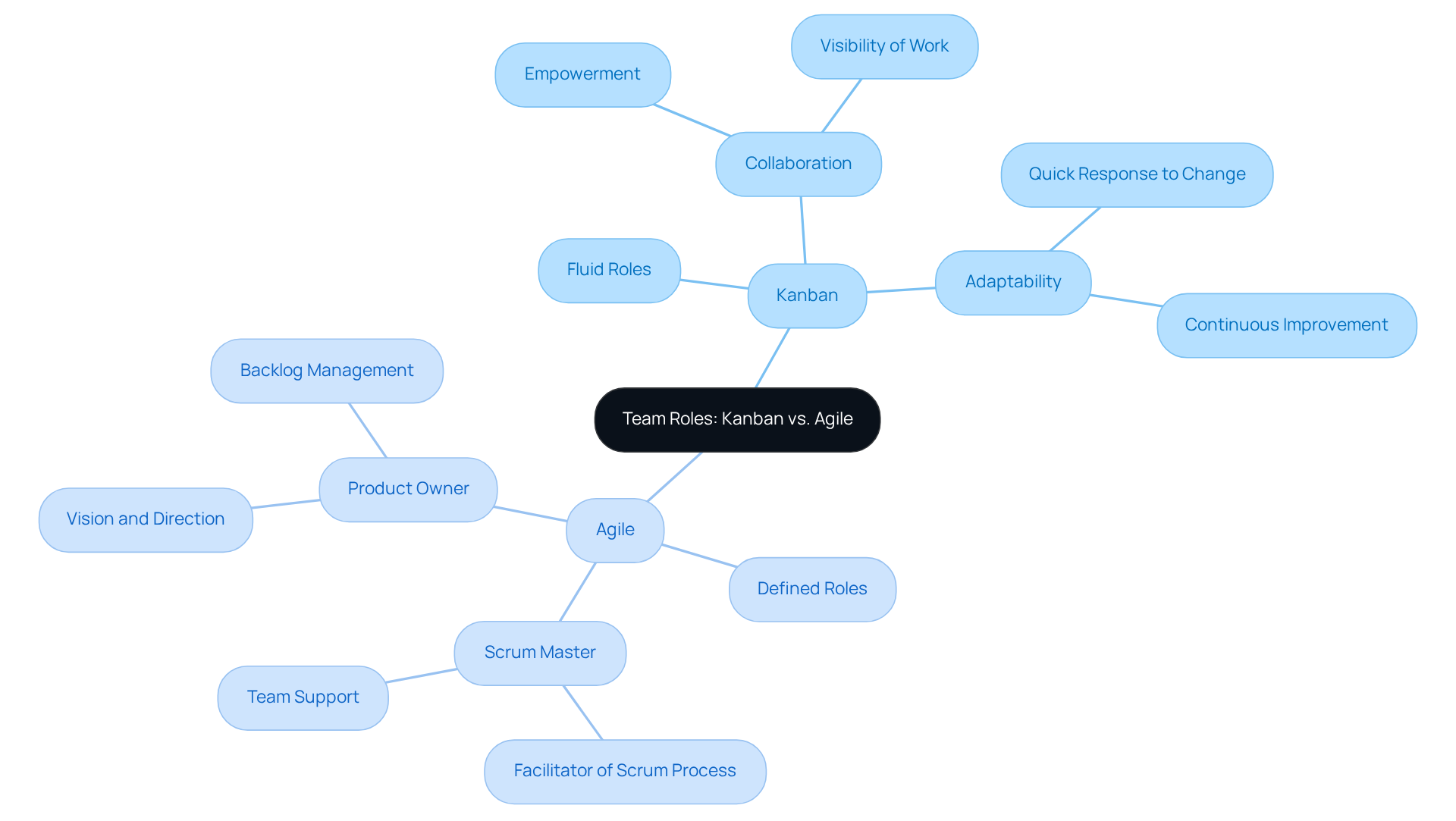
Metrics and KPIs: Tracking Progress in Kanban and Agile
Both methodologies depend on metrics and KPIs to monitor progress and assess success. Kanban groups typically emphasize metrics such as lead time, cycle time, and throughput to evaluate workflow efficiency. In contrast, flexible groups may leverage velocity, sprint burndown charts, and customer satisfaction scores (CSAT) to gauge their performance. As Sumeet Madan asserts, "Agile metrics are measurable data points that help evaluate your group's progress, performance, and effectiveness."
Startups must establish clear metrics aligned with their goals to effectively monitor progress and make data-driven decisions. Research indicates that organizations implementing robust metrics experience a 20% increase in project success rates. Moreover, utilizing a balanced mix of KPIs—such as Work in Progress (WIP) and throughput—can provide a holistic view of group performance and enhance overall productivity.
By understanding the distinctions in kanban vs agile, startups can tailor their tracking methods to better fit operational requirements and foster ongoing enhancement.
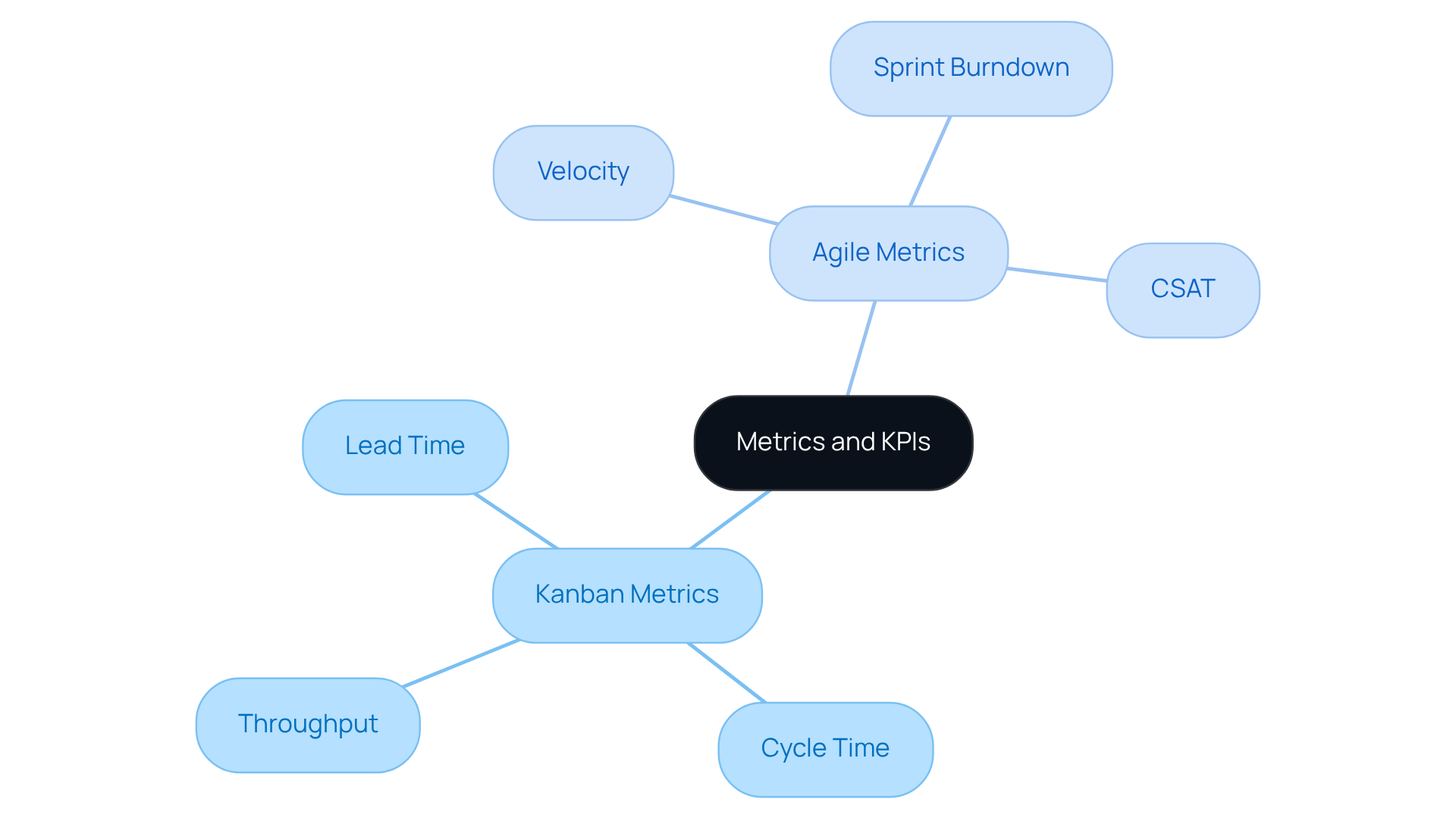
Adaptability: Kanban's Flexibility vs. Agile's Responsiveness
The system is celebrated for its inherent flexibility, enabling teams to modify workflows and priorities in real-time without disrupting ongoing processes. This adaptability is crucial for startups facing unpredictable demands, allowing them to pivot quickly as circumstances change. In contrast, this methodology prioritizes responsiveness to customer feedback and evolving requirements through structured iterations, fostering a culture of continuous improvement.
How can startups assess their operational requirements to discover the ideal equilibrium in the debate of kanban vs agile methodologies? This balance is essential for quickly adjusting to market shifts while preserving effective project management.
Consider this: a notable 76% of professionals expect an increase in their organization's adoption of flexible methodologies, reflecting a growing acknowledgment of its advantages in dynamic environments. Furthermore, almost half of the practitioners of agile methodologies recognize cultural resistance as an obstacle to successful implementation. This highlights the significance of nurturing an agile mindset among groups. By embracing these methodologies, startups can enhance their operational efficiency and responsiveness, ultimately driving better outcomes in a competitive landscape.

Customer Feedback: Agile's Core Principle vs. Kanban's Focus on Flow
Customer input stands as a fundamental principle of iterative development, compelling teams to prioritize user requirements and adapt their offerings accordingly. Flexible methodologies foster frequent feedback cycles, empowering teams to refine their products based on real user experiences. Notably, 93% of flexible organizations report heightened customer satisfaction, underscoring the critical need to align products with user expectations. Moreover, Agile teams employing complete Scrum have exhibited a remarkable 250% improvement in quality compared to those who do not estimate, highlighting the efficacy of Agile methods in enhancing outcomes.
In contrast, while this method maintains a smooth workflow that can incorporate feedback, it may not place as strong an emphasis on it. Startups stand to gain significantly by harnessing customer feedback to inform their development processes, ensuring they create products that resonate with their target audience. By integrating user insights, startups can refine their project management strategies, leading to better alignment with market demands and ultimately, increased overall success. Are you ready to transform your approach by embracing the voice of your customers?
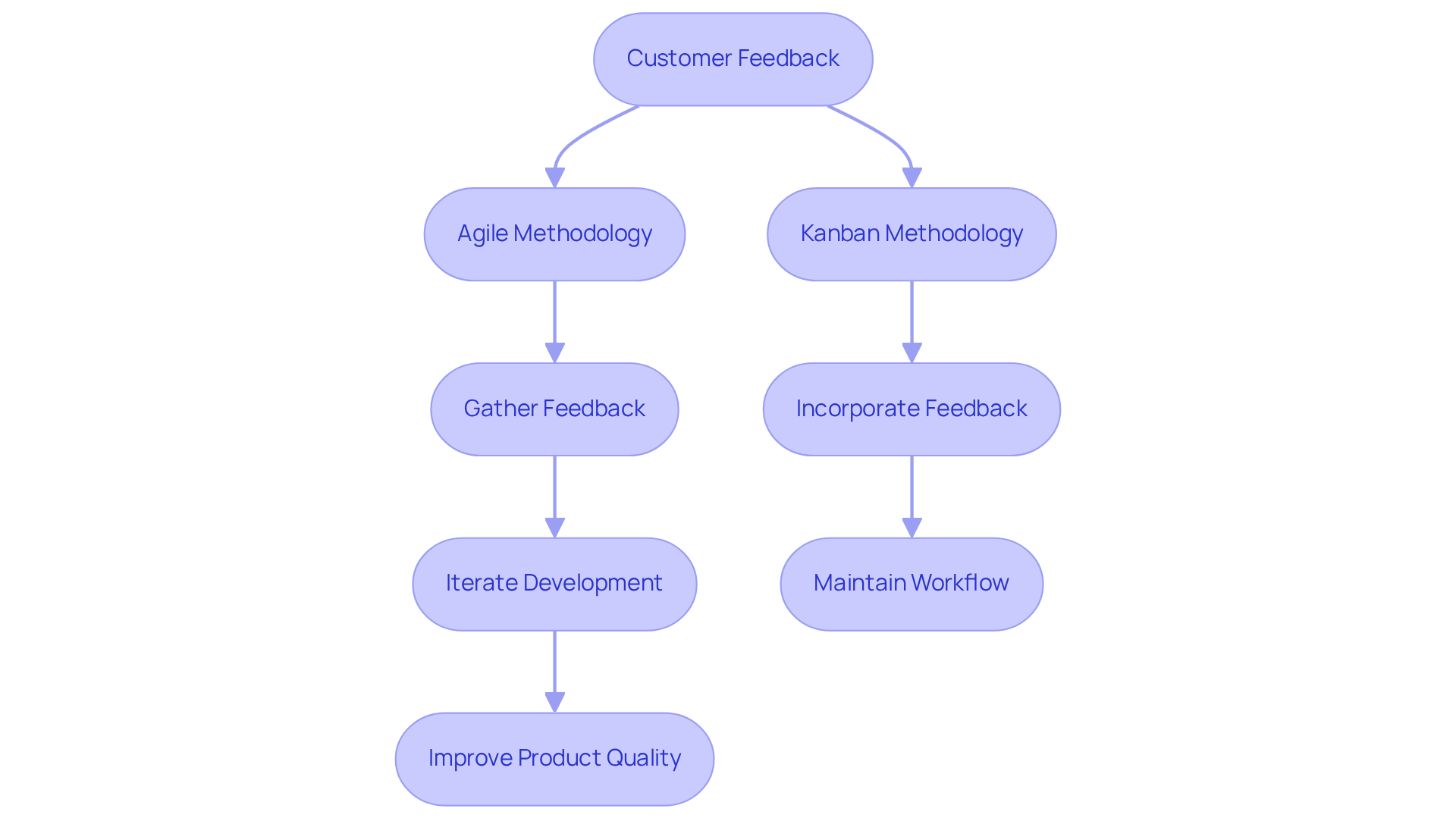
Implementation Challenges: Navigating Kanban and Agile Adoption
Implementing different methodologies such as kanban vs agile presents significant challenges for startups. Key obstacles include:
- Resistance to change
- A lack of understanding of the methodologies
- Difficulties in clearly defining roles and responsibilities
Notably, 34% of organizations report encountering resistance to change when adopting flexible methodologies. This statistic underscores the urgent need for effective strategies to address this issue. Moreover, 29% of organizations lack adequate training and education for agile adoption, highlighting the essential requirement for startups to prioritize training and education to equip their personnel for successful implementation of these frameworks.
Studies indicate that nearly half of practitioners using adaptive methodologies cite inadequate leadership involvement as a recurring issue. Additionally, 41% of organizations implement visual management across ten or more teams or the entire company, emphasizing the importance of fostering a culture of teamwork and continuous improvement. As Tony Marignetti suggests, a mindset shift is crucial for cultivating a culture of adaptability. By embracing these principles, startups can mitigate resistance and facilitate a smoother transition to flexible methodologies, such as kanban vs agile, ultimately enhancing their operational efficiency and responsiveness in a competitive landscape.
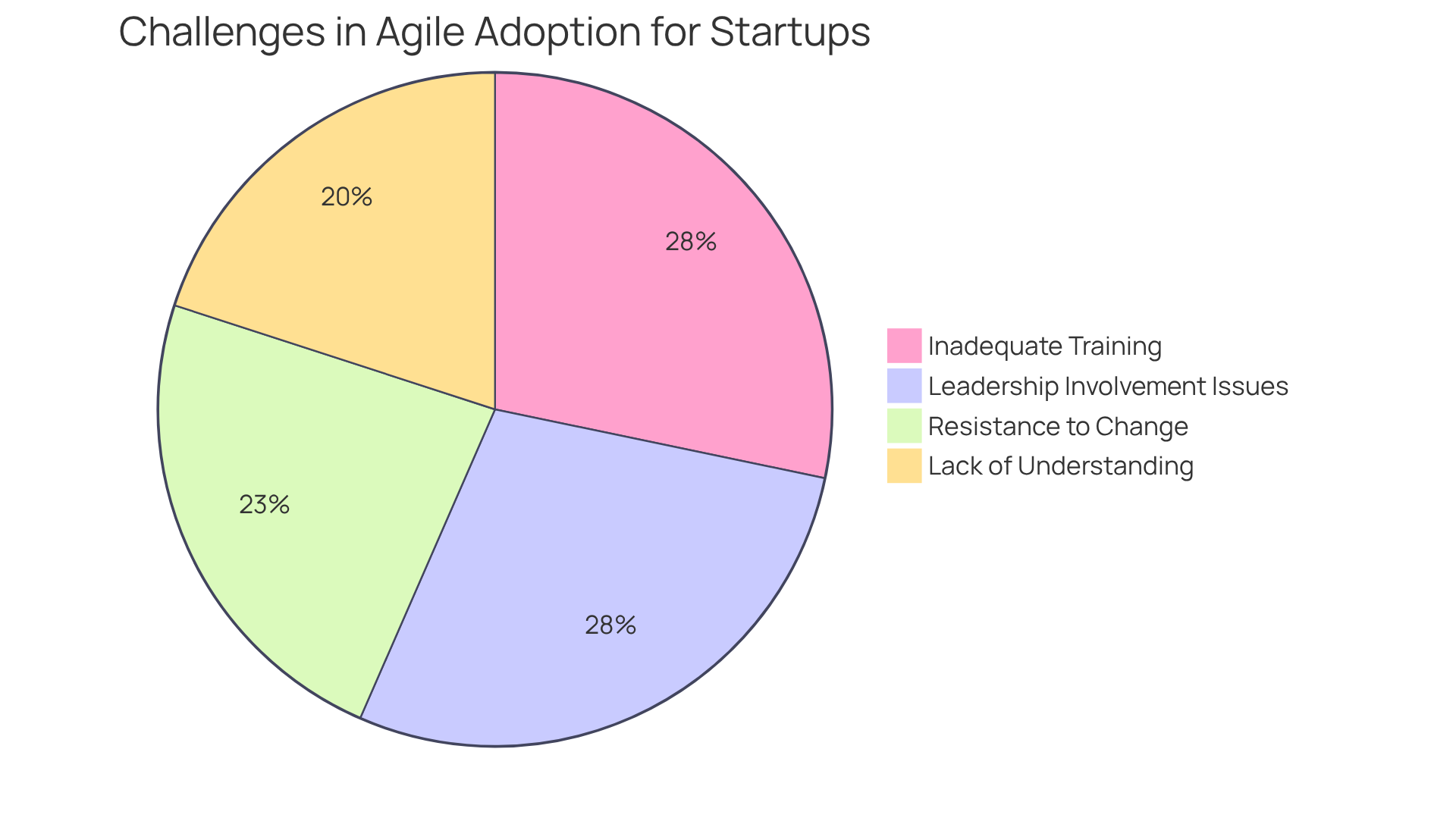
Conclusion: Choosing the Right Methodology for Your Startup's Success
In summary, both methodologies, kanban vs agile, offer valuable frameworks for startups seeking to enhance their management processes. The visual nature and adaptability of the system make it ideal for continuous tasks, while Agile’s iterative phases and focus on client input provide a structured approach to meet evolving needs.
Startups must assess their project requirements, team dynamics, and market conditions to select the methodology that aligns best with their objectives and boosts productivity. Notably, 87% of users of this system report improved outcomes compared to previous management strategies, underscoring its effectiveness in dynamic environments.
For instance, a travel startup successfully reduced its response time to priority shifts from 14 days to just 2 days during the COVID-19 pandemic by implementing Kanban. Furthermore, 86% of marketing leaders plan to transition their teams to flexible methodologies, reflecting a broader trend towards adaptability and responsiveness.
With iterative projects achieving a 42% success rate compared to a mere 14% for Waterfall projects, startups are encouraged to consider this structured approach to navigate uncertain markets. Ultimately, the decision regarding kanban vs agile should align with the startup’s goals and enhance productivity, ensuring that teams can deliver value efficiently while remaining agile in the face of change.
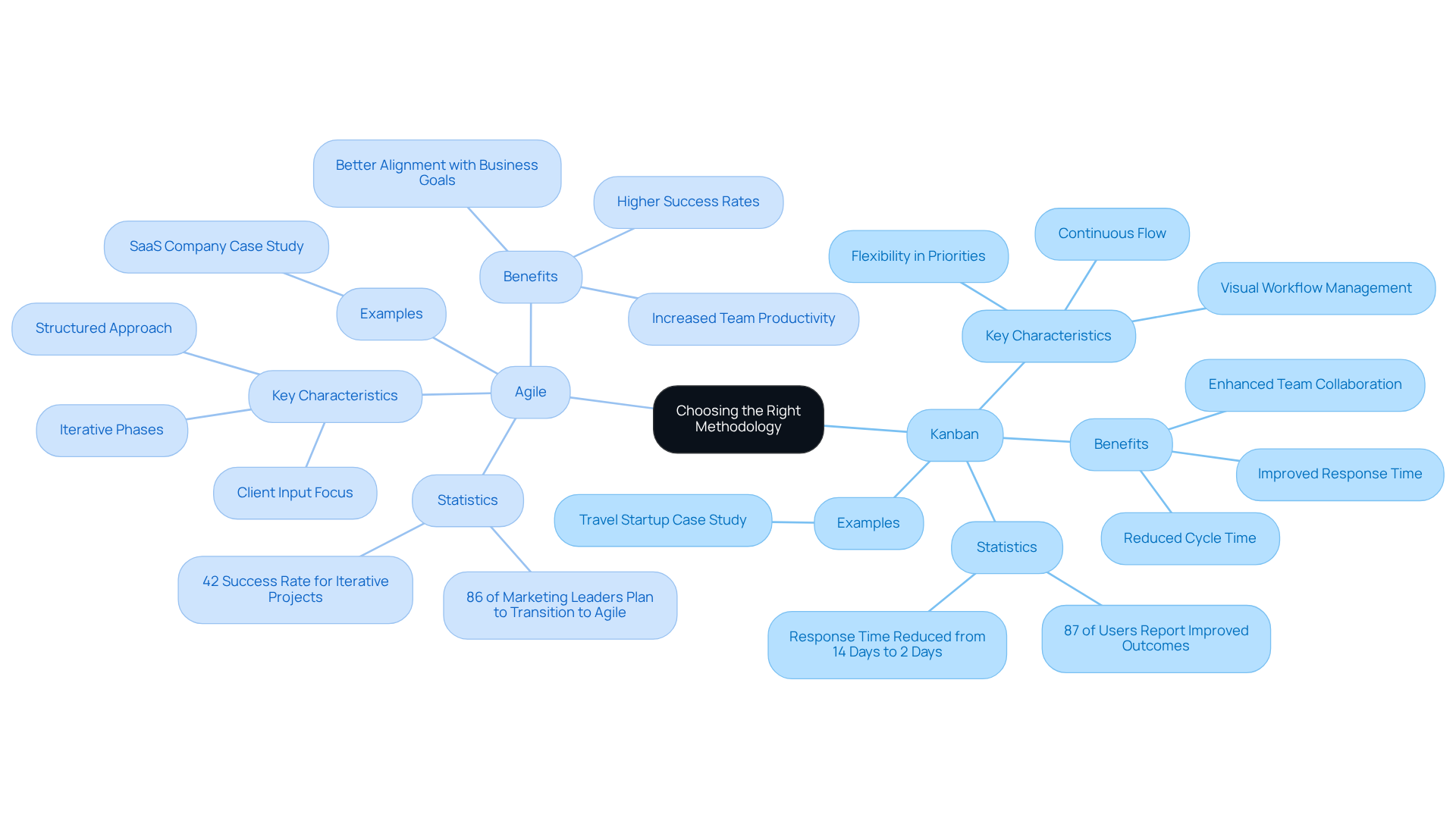
Conclusion
Both Kanban and Agile methodologies offer distinct advantages for startups seeking to refine their project management strategies. Kanban emphasizes visualizing workflows and maintaining a steady flow of tasks, which complements Agile’s iterative approach that prioritizes flexibility and continuous improvement. By grasping the nuances of these methodologies, startups can select the framework that best aligns with their operational needs and team dynamics, ultimately enhancing productivity and responsiveness.
Key insights underscore the significance of adaptability, customer feedback, and the unique metrics employed to measure progress in each methodology. Startups that adeptly implement Kanban can streamline task management and foster collaboration, while those embracing Agile can bolster their capacity to respond to shifting market demands through structured iterations and real-time feedback. The choice between Kanban and Agile should be informed by the specific challenges and objectives of the startup, ensuring a strategic alignment that propels success.
In today’s fast-paced business environment, adopting the right project management methodology is essential for startups. By harnessing the strengths of either Kanban or Agile, organizations can navigate uncertainties, enhance team collaboration, and ultimately deliver greater value to their customers. The future of successful startups hinges on their ability to adapt and thrive, making the selection of methodology a critical factor in their pursuit of sustainable growth.
Frequently Asked Questions
What is Casy and how does it function?
Casy is an automation tool that manages tasks for both kanban and agile workflows by integrating with platforms like Slack and Telegram. It captures information from conversations and converts them into actionable tasks, reducing manual updates and minimizing miscommunication.
How can Casy benefit startups in 2025?
In 2025, startups can utilize Casy to boost productivity and simplify management processes, leading to better outcomes. The use of AI in management, as exemplified by Casy, can decrease task overruns by 35% and enhance efficiency for 84% of users.
What are the key features of the kanban framework?
The kanban framework allows teams to visualize their workflows using boards and cards. It enhances collaboration by providing a transparent overview of tasks and limits work in progress (WIP), helping teams focus on completing tasks efficiently and reducing the risk of overload.
How does agile methodology support startups?
Agile methodology prioritizes flexibility and continuous improvement, making it suitable for startups in dynamic environments. It allows teams to adapt strategies based on real-time feedback and complete tasks in smaller increments, fostering a culture of ongoing enhancement.
What are the reported benefits of adopting agile practices?
Organizations that embrace agile practices report a 93% improvement in customer satisfaction and a 76% increase in employee engagement. These practices also help marketing teams prioritize tasks more efficiently, with 76% of marketers noting enhanced productivity.
What challenges might startups face when adopting flexible methodologies?
One significant challenge is inadequate leadership involvement, which has been cited by 41% of respondents. Strong support from leadership is essential for successfully adopting flexible methodologies.




